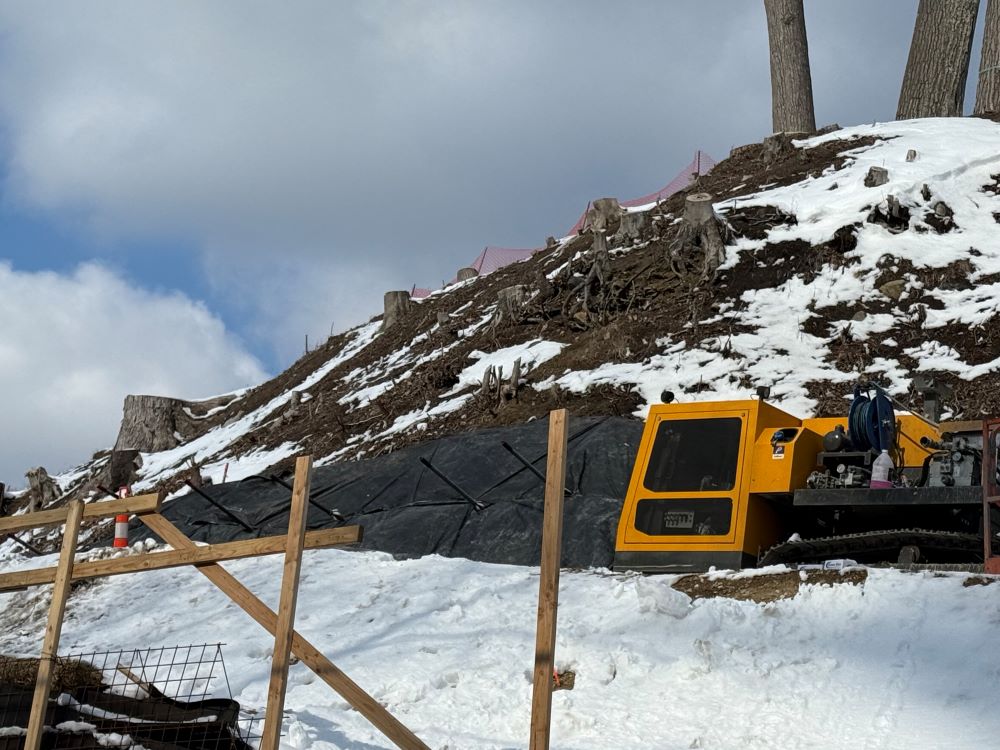New Design Speeds Route 44 Retaining Wall Project
Traffic Signals Updated
By Avice Meehan

The dirt ramps in place at the Route 44 project have enabled workers to install steel rods called soil nails that stabilize the slope.
The signals that control access through the retaining wall project on Route 44 now have count-down clocks and the Connecticut Department of Transportation (DOT) has also added a temporary light at Blackberry Street for motorists trying to enter the construction zone.
Those improvements—all intended to lower the stress levels experienced by the driving public—pale in comparison to the design and schedule changes that will shave two years off the project schedule. The revised timeline was announced late last year by DOT’s District 4 office in Thomaston, but the statement provided few details about what enabled a 2026 completion date.
Amy E. Hare, a DOT engineer in the Office of Construction, provided some of the details in a recent video interview. She also explained the work that is currently underway and she shared background about the workings of the signal light system.
First, the lights. Hare said the major complaints about the project have involved the delays caused by the temporary signals and that DOT was trying to address those concerns. She said First Selectman Matt Riiska was particularly concerned about improving access to Blackberry Street for residents and commercial trucks.
“We are trying to make this as smooth as possible,” she said. “With the countdown clocks, people will have a sense of their wait times. It requires patience.”
The traffic signal has a built-in detection system for emergency vehicles and gives them precedence. Hare said that DOT met with Norfolk fire and ambulance ahead of time to make sure that the detection system worked. She acknowledged that emergency personnel still must wait for vehicles already in the queue and that concerns people like Sandy Evans, president of the Norfolk Lions Club Ambulance.
“Since we cannot see if anyone is in “the chute” it could prove a big problem,” she said.
At least the project is now scheduled for completion in 2026, instead of 2028, and is expected to come in under the original $37.2 million cost. K2 Infrastructure Group, Inc., awarded the contract in April 2024, asked DOT to consider a change in the way the retaining walls are built during the fall.
“Our original design called for a mechanically stabilized earth wall,” said Hare. “Although the walls would have functioned in the same way, the [new] design makes for less excavation. Originally, that would have reached almost to the cemetery.”
K2 proposed something called a soldier pile and lagging retaining wall and, after reviewing the proposal, DOT agreed. Giant casings—those big pipes currently being stored along Route 44—will be drilled into the ground at specific intervals. They will be filled with concrete to create the framework of the new wall and support a gentler slope coming down from Center Cemetery above. As shown in earlier presentations by DOT, the exterior facing will have a texture that looks like stone.
Right now, of course, the project takes up a lot of space. “It will look very different in the final configuration, but we have to take up space with the temporary dirt ramps in order to get equipment to the right height,” said Hare.
The dirt ramps in place have enabled the team from K2 to install steel rods called soil nails that stabilize the slope. Later this winter, the dirt ramps will be removed and a layer of shotcrete—otherwise known as sprayed concrete—will be applied to slope. Once that happens, K2 will have the space and stable slope that’s needed to install the soldier pile wall.
“[The site] will look very different from week to week,” said Hare. At some point, the traffic lane will shift to the opposite side of Route 44 and eventually, the temporary signals will shift down Route 44 to the area surrounding the second retaining wall. To make sure the work proceeds according to specifications, a five-person inspection team from a company called GM2 is onsite.
As recently reported by the Connecticut Mirror, the impact of recent executive orders on transportation projects in Norfolk and elsewhere is not yet known.
According to the Connecticut Mirror, the effect, if any, of the Jan. 28 presidential executive orders on local transportation project is not yet known. Josh Morgan, a spokesperson for the Connecticut Department of Transportation, said it remained “unclear” at this point what impact the orders would have on the agency’s operations, about half of which are funded through the federal government.
“We’re awaiting guidance and instructions from US DOT,” Morgan said in a statement to the Connecticut Mirror. “Our programs are reimbursements, so we pay up front and the feds pay us back.”
